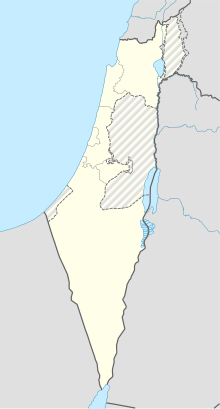Tell es-Samak (Arabic: تل السمك, romanized: Tell as-Samak), or Tel Shikmona (Hebrew: תל שִׁקְמוֹנָה, romanized: Šiqmônah), also spelt Sycamine,[1] is an ancient Phoenician tell (mound) situated near the sea coast in the modern city of Haifa, Israel, just south of the Israeli National Institute of Oceanography. It has been called a "forgotten Phoenician site".[2] Nowadays researchers identify Tell es-Samak with Porphyreon (south).
تل السمك | |
 | |
| Location | |
|---|---|
| Region | Haifa |
| Coordinates | 32°49′30″N 34°57′19″E / 32.82500°N 34.95528°E |
History edit
In the Periplus of Pseudo-Scylax it is mentioned the Sykaminon (Συκάμινον) as a city of the Tyrians, and also that there was a river of the same name.[3] Stephanus of Byzantium called it Sykaminon (Συκαμίνων) and called it a city of the Phoenicians.[4]Josephus in his Antiquities mentions Sycamine as being a place where ships could be brought to harbor, and where Ptolemy Lathyrus, during an incursion in the country, had brought his army ashore.[5] Strabo mentions the site (Sycaminopolis, Συκαμίνων πόλις) as being no more than a ruin in his own day.[6] The Mishnah (Demai 1:1), compiled in 189 CE, mentions the region of Tell es-Samak as being renowned for its cultivated variety of jujubes. The Bordeaux pilgrim in 333 CE passed through Sycaminon while traveling through the Holy Land.[7]
Archaeology edit
Excavation history edit
The main archaeological excavations conducted at the tell and in the Byzantine city south of it, were carried out by the archaeologist J. Elgavish in the 1960s–70s on behalf of the Department of Museums, Municipality of Haifa.
Salvage excavations were conducted in the 1990s by the Israel Antiquities Authority (IAA) and concentrated in the eastern part of the Byzantine city, west of the Carmel Mountain slopes, where the city's necropolis is. In 2010–2011 a new series of excavation seasons was conducted by a team from the Zinman Institute of Archaeology at the University of Haifa, headed by Dr. Michael Eisenberg with Dr. Shay Bar directing the excavations on the tell itself. The goals of the project were to re-expose excavated archaeological complexes south and east of the tell previously excavated by Elgavish, expand those areas and undertake extensive conservation work in order to preserve the antiquities and present them to the public as part of Shikmona Public Park. The work also aimed to study the stratification of the tell and create a precise chronological framework.[8][9][10]
Findings edit
The remains on the tell date from the Late Bronze Age to the Late Byzantine period. The lower city, east and mainly south of the tell, is dated to the Late Roman period-Byzantine period. No remains have been found dating to the Early Arab period, leading the archaeologists to conclude that Tell es-Samak was abandoned before the 7th century CE.
Tell es-Samak has yielded various types of sherds, the most common of which belonging to the red-slipped plates and bowls (Eastern sigillata A) made on the Phoenician coast during the 1st century CE.[11] In addition, archaeologists discovered evidence for dyeing industry based on the Murex sea snail, also known as Tyrian purple, dating back to the Iron Age.[12] The purple dye extracted from the mollusk was used by the potters of Tell es-Samak to paint pottery. After the discovery, the entire collection of painted pottery underwent a chemical analysis to determine the make-up of the paint, during which time it was confirmed that the color was an authentic purple dye extracted from the Murex sea snail.[13]
Identification
It is agreed among scholars that the site, Tell es-Samak, has no identification so far during the Biblical periods. Latest historical and archaeological research points towards the identification of the site during Hellenistic-Byzantine periods as Porphyreon (south). This new identification fits with the clear Christian remains at the site and the absence of Jewish ones as should be expected from Tell es-Samak.[14]
Nature reserve and national park edit
Tell es-Samak was declared a 1677-dunam nature reserve in 2008. A small area (73 dunams) was declared a national park, as well.[15]
References edit
- ^ Josephus, Antiquities 13.12.3.
- ^ Shalvi, Golan. (2020). Tel Shiqmona: a Forgotten Phoenician Site on the Carmel Coast.
- ^ Pseudo Scylax, Periplous, 104
- ^ Stephanus of Byzantium, Ethnica, S591.7
- ^ Josephus, Antiquities 13.12.3. Cf. Samuel Klein, Sefer Ha-Yishuv, vol. 1, Bialik Institute: Jerusalem 1939, p. 155, who identifies Sycamine with Shikmona near Old Haifa.
- ^ Strabo's Geography 16.2.27.
- ^ "Itinerary from Bordeaux to Jerusalem - 'The Bordeaux Pilgrim' (333 AD)", trans. by Aubrey Stewart, London 1887, pub. in: Palestine Pilgrim's Text Society, vol. 1, p. 43
- ^ "Zinman Institute of Archaeology Shikmona Archaeological Project". Zinman Institute of Archaeology. Retrieved 2017-04-17.
- ^ "Zinman Institute of Archaeology Shikmona Archaeological Project poster" (PDF). Zinman Institute of Archaeology. Retrieved 2017-04-17.
- ^ Eisenberg, M.; Bar, S., eds. (September 2021). "Tell es-Samak (Shikmona/Porphyreon) on the Haifa Coast". Michmanim (29). Hecht Museum. ISSN 0334-7311.
- ^ Andrea M. Berlin, "Jewish Life Before the Revolt: The Archaeological Evidence", in: Journal for the Study of Judaism in the Persian, Hellenistic, and Roman Period, vol. 36, no. 4 (2005), p. 445.
- ^ "The Price of Purple: Archaeologists have found new evidence of a robust dye industry that endured on the Mediterranean coast for millennia". archaeology.org. 2020.
- ^ Israel Antiquities Authority - The Forty-fifth Archaeological Congress in Israel, The ancient purple industry in Tel Shekmona, p. 8 (in Hebrew)
- ^ Eisenberg, Michael (2021). "Tell es-Samak (Porphyreon/Shikmona) in the Hellenistic, Roman and Byzantine Periods". Michmanim. 29: 55–78.
- ^ "List of National Parks and Nature Reserves" (PDF) (in Hebrew). Israel Nature and Parks Authority. Archived from the original (PDF) on 2009-10-07. Retrieved 2010-09-27.
